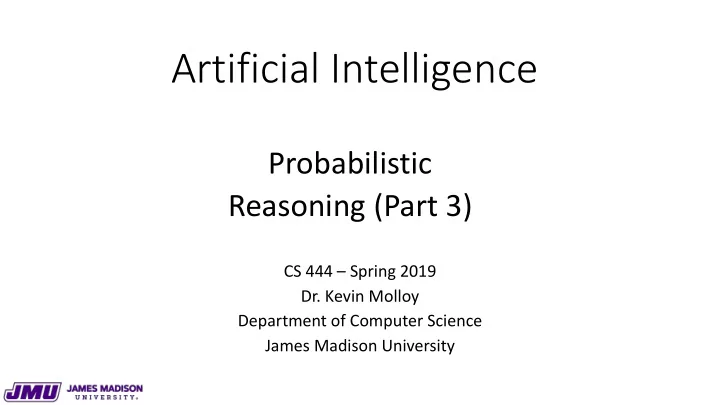

Artificial Intelligence Probabilistic Reasoning (Part 3) CS 444 – Spring 2019 Dr. Kevin Molloy Department of Computer Science James Madison University
Some Exercises Consider this Bayesian network. 1. If no evidence is observed, are Burglary and Earthquake independent? Explain why/why not. 2. If we observe Alarm = true, are Burglary and Earthquake independent? Justify your answer by calculating whether the probabilities involved satisfy the definition of conditional independence.
Compact Conditional Distributions CPT grows exponentially with number of parents CPT becomes infinite with continuous-valued parent or child Solution: canonical distributions that are defined compactly Determinitic nodes are the simplest case: X = f(Parents(X)) for some function f e.g. boolean functions NorthAmerican ⟺ Canadian ∨ US ∨ Mexican e.g. numerical relationships amongst continuous variable
CCD (Compact Conditional Distributions) Noisy-OR distributions model multiple noninteracting causes 1. Parents U 1 … U k include all causes (can add leak node) 2. Independent failure probability q i for each cause alone ( Cold Flu Malaria P(Fever) P(¬Fever) ⟹ P(X | U1 … Uj, ¬Uj+1 … ¬Uk) = 1 - ∏ %&' 𝑟 % F F F 0.0 1.0 F F T 0.9 0.1 Number of parameters is linear in F T F 0.8 0.2 number of parents. F T T 0.98 0.02 = 0.2 x 0.1 T F F 0.4 0.6 T F T 0.94 0.06 = 0.6 x 0.1 T T F 0.88 0.12 = 0.6 x 0.2 T T T 0.988 0.012 = 0.6 x 0.2 x 0.1
Hybrid (Discrete + Continuous) Networks Option 1: discretization Option 2: finitely parameterized canonical families. 1. Continuous variable, discrete + continuous parents (e.g., Cost ) 2. Discrete variable, continuous parents (e.g. Buys )
Continuous Child Variables Need one conditional density function for child variables given continuous parents, for each possible assignment to discrete parents. Most common is the linear Gaussian model, e.g.,: P(Cost =c | Harvest = h, Subsidy? = true) = N(ath + bt, 𝜏 )(c) : 1 exp(− 1 𝑑 − 𝑏 - ℎ + 𝑐 - = ) 2 𝜏 - 𝜏 - 2𝜌 Mean Cost varies linearly with Harvest, variance is fixed. Linear variation is unreasonable over the full range But works OK if the likely range of Harvest is narrow
Continuous Child Variables All continuous network with LG distributions: ⟹ full joint distribution is a multivariate Gaussian
Discrete Variable w/Continuous Parents Probability of Buys? Given Cost should be a soft threshold: Probit distsribution uses integral of Gaussian.
Why the probit? Its sort of the right shape, can view as hard threshold subject to noise.
Discrete Variable Sigmoid (or logit) distribution is also used (and frequently in neural networks). Sigmoid has similar shape (but longer tails).
Summary on Bayesian Networks Bayes nets provide a natural representation for (causally induced) conditional independence. Topology + CPTs = compact representation of joint distributions Generally easy for (non)expexrts to construct Canonical distributions (noisy-OR) = compact representation of CPTs Continuous variables ⟹ parameterized distribution (e.g. linear Gaussian)
Recommend
More recommend